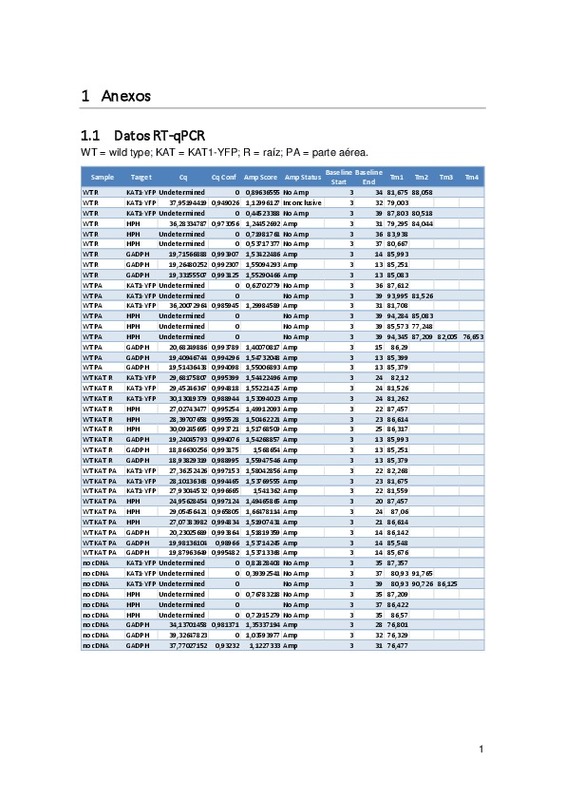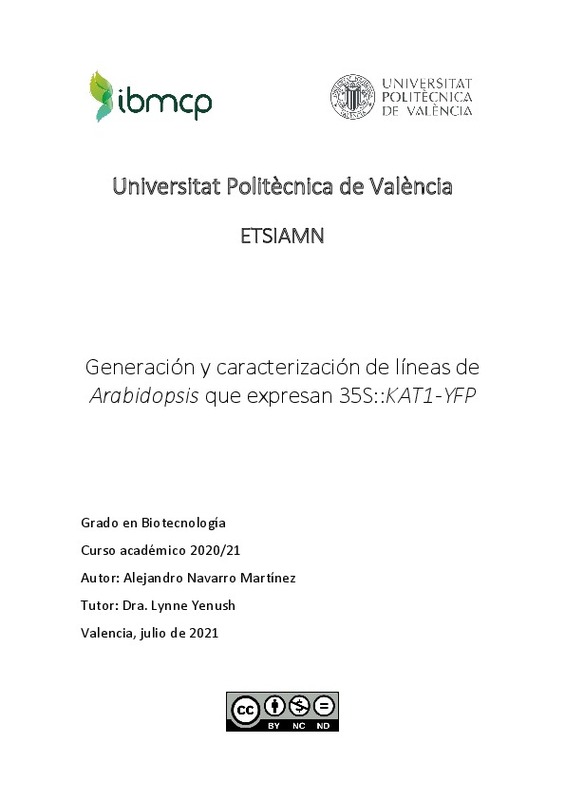JavaScript is disabled for your browser. Some features of this site may not work without it.
Buscar en RiuNet
Listar
Mi cuenta
Estadísticas
Ayuda RiuNet
Admin. UPV
Generación y caracterización de líneas de Arabidopsis que expresan 35S::KAT1-YFP
Mostrar el registro sencillo del ítem
Ficheros en el ítem
| dc.contributor.advisor | Yenush, Lynne Paula
|
es_ES |
| dc.contributor.advisor | Andrés Colás, Nuria
|
es_ES |
| dc.contributor.author | Navarro Martínez, Alejandro
|
es_ES |
| dc.date.accessioned | 2021-09-01T15:41:02Z | |
| dc.date.available | 2021-09-01T15:41:02Z | |
| dc.date.created | 2021-07-20 | |
| dc.date.issued | 2021-09-01 | es_ES |
| dc.identifier.uri | http://hdl.handle.net/10251/171183 | |
| dc.description.abstract | [ES] El canal de potasio (K+) rectificador de entrada KAT1 se encuentra altamente expresado en la membrana plasmática de las células oclusivas. Allí, junto con su homólogo KAT2, juega un papel esencial para el aumento de turgencia de estas células, lo que permite la apertura del estoma. En investigaciones previas, se han identificado proteínas que interaccionan con el canal y regulan su transporte hasta la membrana plasmática, como BAG4 o VAMP721. No obstante, todavía faltan muchas piezas del puzle por caracterizar. En este trabajo, hemos confirmado nuestra observación preliminar que sugería que líneas de Arabidopsis thaliana transformadas con 35S::KAT1-YFP, sólo expresan la proteína KAT1-YFP en la membrana plasmática de las células oclusivas. Esta observación sugiere la existencia de un mecanismo de regulación de KAT1 que provoca que la proteína sólo se exprese en un tipo celular. Además, también observamos que KAT1-YFP no es detectable en hojas viejas. Con el objetivo de poder estudiar la regulación de KAT1 mediante microscopía confocal con mayor facilidad, se generaron líneas homocigotas kat1 KAT1-YFP. Se comprobó que estas líneas complementaban la función de KAT1, con lo que pueden considerarse funcionalmente equivalentes a una línea wild type. Asimismo, se realizó un estudio de la expresión génica de 35S::KAT1-YFP mediante RT-qPCR en 2 líneas, comparando un tejido en el que se observa expresión de KAT1-YFP (parte aérea) con otro en que su expresión no es detectable (raíz). Se encontraron niveles significativos del transcrito en ambos tejidos, con lo que es improbable que la regulación de KAT1 que restringe la acumulación de KAT1 exclusivamente en las células oclusivas, ocurra a nivel de mRNA. También se realizó una inmunodetección de KAT1-YFP en ambos tejidos, y se comprobó que era posible detectarlo en parte aérea, mientras que los resultados en raíz fueron inconcluyentes. | es_ES |
| dc.description.abstract | [EN] The inward-rectifying potassium (K+) channel KAT1 is highly expressed in the plasma membrane of guard cells. There, together with its homolog KAT2, it plays a key role in the increase of turgor of these cells, which helps drive stomatal aperture. In previous investigations, proteins which interact with this channel and regulate its trafficking towards the plasma membrane, have been identified, like BAG4 or VAMP721. However, there are still many puzzle pieces left for characterization. In the present work, we confirmed our preliminary observation suggesting that Arabidopsis thaliana lines transformed with 35S::KAT1-YFP only express the protein KAT1-YFP on the plasma membrane of guard cells. This observation suggests that a regulatory mechanism exists for KAT1 that is responsible for the expression of the protein in a single cell type. In addition, we also observed that KAT1-YFP is not detectable in old leaves. With the goal of being able to study the regulation of KAT1 by confocal microscopy more easily, homozygous kat1 KAT1-YFP lines were generated. Functional complementation of KAT1 was verified in these lines, so they can be considered functionally equivalent to a wild type line. Moreover, a gene expression study of 35S::KAT1-YFP by RT-qPCR was performed in 2 lines, comparing a tissue were KAT1-YFP expression is observed (aerial part) with another one where its expression is not detectable (root). Significant levels of the transcript were found in both tissues, so it is unlikely that the regulation of KAT1 that restricts the accumulation of KAT1 exclusively in guard cells occurs at the level of mRNA. An immunodetection of KAT1-YFP in both tissues was carried out as well, and detection in the aerial part was confirmed, while the results for the root tissue were inconclusive. | es_ES |
| dc.format.extent | 41 | es_ES |
| dc.language | Español | es_ES |
| dc.publisher | Universitat Politècnica de València | es_ES |
| dc.rights | Reconocimiento - No comercial - Sin obra derivada (by-nc-nd) | es_ES |
| dc.subject | KAT1 | es_ES |
| dc.subject | 35S | es_ES |
| dc.subject | Arabidopsis thaliana | es_ES |
| dc.subject | Regulación | es_ES |
| dc.subject | Células oclusivas | es_ES |
| dc.subject | Complementación funcional | es_ES |
| dc.subject | RT-qPCR | es_ES |
| dc.subject | Inmunodetección | es_ES |
| dc.subject | Regulation | es_ES |
| dc.subject | Guard cells | es_ES |
| dc.subject | Functional complementation | es_ES |
| dc.subject | Immunodetection | es_ES |
| dc.subject.classification | BIOQUIMICA Y BIOLOGIA MOLECULAR | es_ES |
| dc.subject.other | Grado en Biotecnología-Grau en Biotecnologia | es_ES |
| dc.title | Generación y caracterización de líneas de Arabidopsis que expresan 35S::KAT1-YFP | es_ES |
| dc.type | Proyecto/Trabajo fin de carrera/grado | es_ES |
| dc.rights.accessRights | Abierto | es_ES |
| dc.contributor.affiliation | Universitat Politècnica de València. Departamento de Biotecnología - Departament de Biotecnologia | es_ES |
| dc.contributor.affiliation | Universitat Politècnica de València. Escuela Técnica Superior de Ingeniería Agronómica y del Medio Natural - Escola Tècnica Superior d'Enginyeria Agronòmica i del Medi Natural | es_ES |
| dc.description.bibliographicCitation | Navarro Martínez, A. (2021). Generación y caracterización de líneas de Arabidopsis que expresan 35S::KAT1-YFP. Universitat Politècnica de València. http://hdl.handle.net/10251/171183 | es_ES |
| dc.description.accrualMethod | TFGM | es_ES |
| dc.relation.pasarela | TFGM\143271 | es_ES |
Este ítem aparece en la(s) siguiente(s) colección(ones)
-
ETSIAMN - Trabajos académicos [3541]
Escuela Técnica Superior de Ingeniería Agronómica y del Medio Natural







